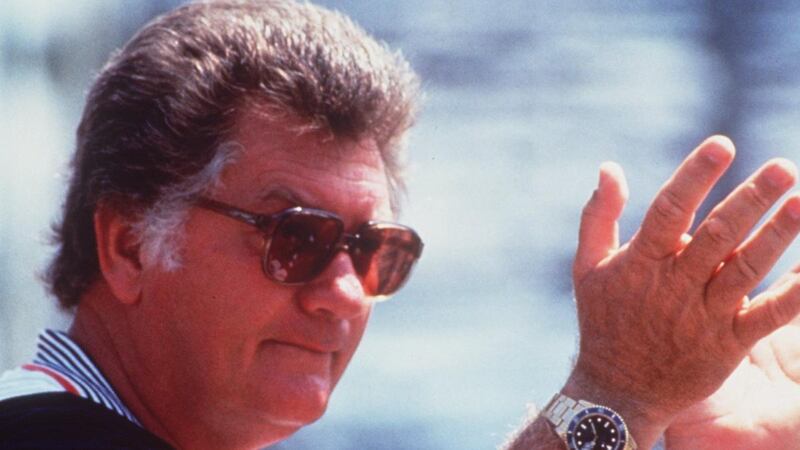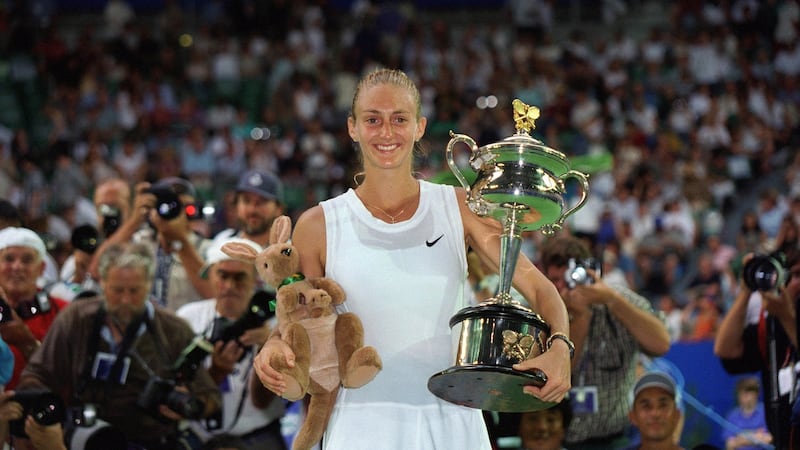Twenty years ago, Mary Pierce was being dragged across the court. As she chased Monica Seles's blows from side-to-side during their 2000 French Open quarter-final match, one vicious drive volley flew straight towards her. Pierce instinctively leaped into the air and connected with the ball between her legs, which lobbed high over Seles's head and landed perfectly inside the court. The shot has been replayed millions of times.
For most players, Pierce's famous tweener would have been a great omen of things to come. But tennis fans had spent a decade as attuned to Pierce's demeanour as the actual strokes. The question was always, after all she had been through, if she was relaxed and loose enough to ever fly. As the crowd roared, the answer came: Pierce sprinted the width of the court in glee and a smile glossed her face. A few days later she had beaten the world No 3, Seles, the No 1, Martina Hingis, and Conchita Martínez, the No 5, and become the first French singles champion at Roland Garros since 1983.
Even today, after the rise of power, weight training and greater racket technology in the women’s game, few players have ever struck a ball like Mary Pierce. After Seles, Pierce was one of the first players to arrive at the baseline determined to excoriate every ball and off both wings.
Nobody was ever safe from being rendered a spectator in their own match, not even the greatest players in history. At the 1994 French Open, Steffi Graf watched in horror as she was hit clean off the court, 6-2, 6-2, in the semi-final. "There was very little I could do," Graf said. In March 2000, it was Serena Williams's turn to be obliterated. Williams lost 6-2, 6-1 and her conclusion was almost identical: "Everything she hit was either on the line or a winner. So, I mean, what can you do?"
Pierce’s father, Jim, realised his daughter’s potential after witnessing a few of her first strikes of a ball. A measure of her talent was that he had handed her a racket for the first time at the relatively late age of 10, yet she became the youngest American to turn professional, at 14 years and two months.
Sabotaged
As Pierce began to compete her talent was, for a long time, sabotaged by her father’s behaviour. Jim Pierce built his reputation with swiftness. He trash-talked opponents, he fought with their parents and then loudly berated his daughter in public. He also loved to brag about it. At the 1987 Orange Bowl, one of the biggest junior tournaments, he yelled “Mary, kill the bitch.”
Those were just the junior events. Pierce’s transition to the professional tour in the early 90s brought breathless coverage of her father’s antics. Although much of the coverage was critical, plenty was gratuitous. Some people were enjoying this. The ticking time bomb culminated at the 1992 French Open where he was ejected from the grounds after punching two Dutch fans. It would prompt a Women’s Tennis Council law, casually referred to as the ‘Jim Pierce rule’, which signified that a part of a player’s entourage could be banned from any event. Its eponym soon fell foul of it when he was banned from the tour in 1993.

Mary Pierce finally severed contact with her father and he was banned from tournaments as she filed a restraining order – but that did not stop him. He would follow her travels close behind, checking into her tournament hotels. She hired bodyguards, and one day he fought one of them, his blood splattering the corridor of an Italian hotel while his daughter had locked herself in an adjacent room. After years of holding her tongue, she was finally ready to speak about the physical abuse she said she received in a 1993 Sports Illustrated cover story titled: “Why Mary Pierce Fears For Her Life”.
Pierce's story was a singular horror and a sign of the times, as 90s women's tennis was defined by the overbearing parent. As she established herself, Pierce had always been compared to Jennifer Capriati, who was a year younger. As Pierce evaded her father in 1993, Capriati, whose career was driven by her prominent father, Stefano, fell off the rails. Mirjana Lucic and Jelena Dokic have spoken out against the abuse they say they received from their fathers. Dokic's 2017 autobiography, Unbreakable, is a study of the cycle of abuse and her cruel inability to escape her father, Damir.
Reminders of the outsized visibility of tennis parents in the 1990s appear everywhere. In 1993, Jim Pierce was interviewed by New York Times contributor Samantha Stevenson about his banishment. By the end of the decade, her daughter, Alexandra, had reached the 1999 Wimbledon semi-final and Samantha Stevenson had become one of the most prominent and eccentric parents on tour.
Tennis parents
Tennis parents are no longer as prominent in today’s game, but they are surely still present as children are continually elected as the breadwinners in a sport that still supports only a few.
The sport presents an opportunity for adult figures to assert power, unlike any team sport. For female athletes, it remains the greatest ticket to wealth – from her own humble beginnings Naomi Osaka was named by Forbes last week as the highest yearly-earning female athlete in history. But in tennis the financial risks are as great as the possible rewards, and since progress rests on the shoulders of the player, so often they receive the blame when things go awry.
After her 2000 triumph in Paris, Pierce would spend another four seasons in the wilderness before she returned to top form again in the spring of 2005, returning to the top-five with finals at the French Open and the US Open. She won two slam titles in total, the other being the 1995 Australian Open, and reached another four finals. Her career was ended the following year by a knee ligament tear. Now 45 and a devout Christian, she says her faith allowed her to forgive her father, who died from cancer in 2017, and they were finally able to share a healthier relationship once she retired.

Pierce’s French Open success touched another subject. Born in Canada to an American father and a French mother, she held three passports and had started her tennis career with the USA flag attached to her name. Long before discussions of Andy Murray’s nationality, Pierce was French when she won and American when she lost. Her Frenchness was up for debate, even though she is the most successful French singles player in Paris in the Open era, with finals in 1994, 2000 and 2005.
Many people still fail, or refuse, to understand that an individual can be the product of multiple cultures and represent and appreciate each of them fully. It remains a point of frustration for Pierce. “I played three finals. Who is the French representative who did this in the history of modern tennis? Even today, I feel that I am not accepted as Mary the French. I don’t understand it.” she told Le Figaro last week.
It is fitting then that, in the good and the bad, from her father’s behaviour at the beginning to the way she stepped into the light and played for herself, Roland Garros will always be her tournament. - Guardian















